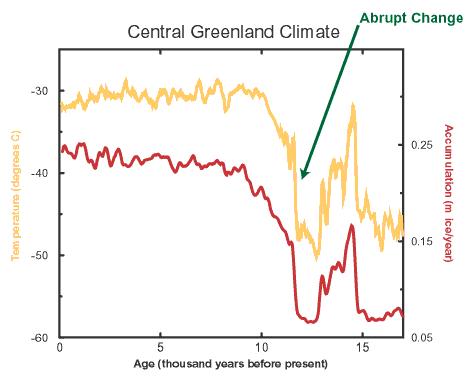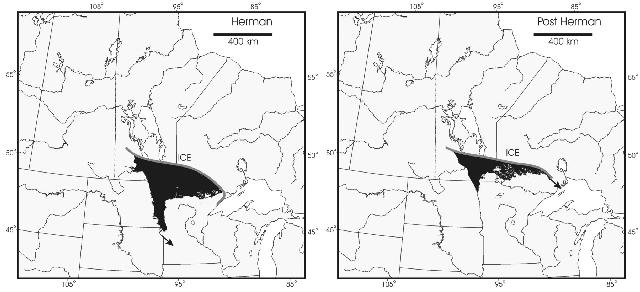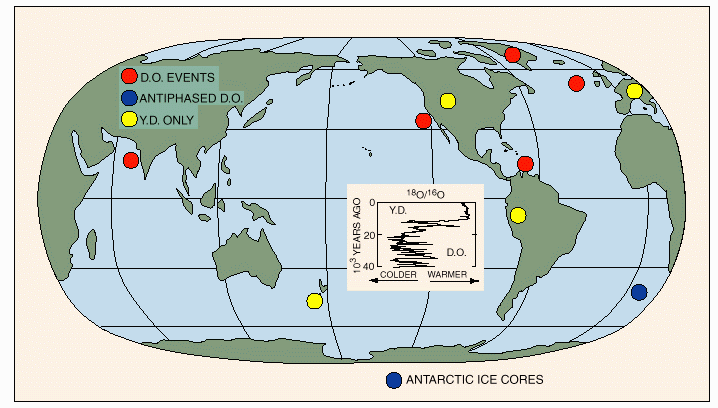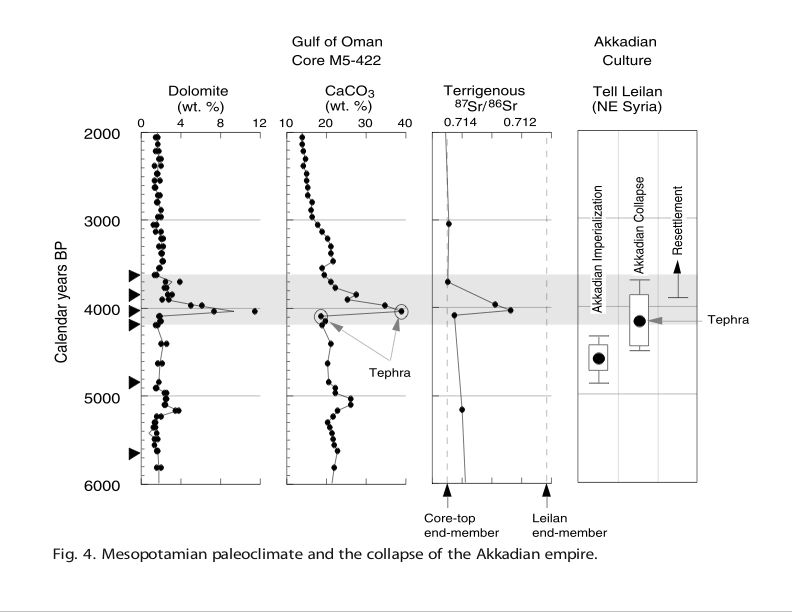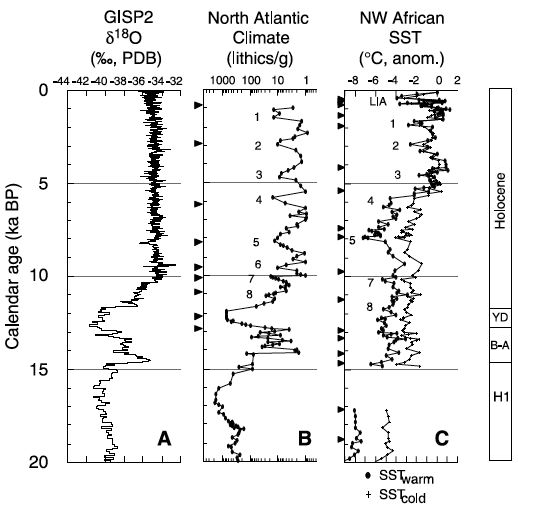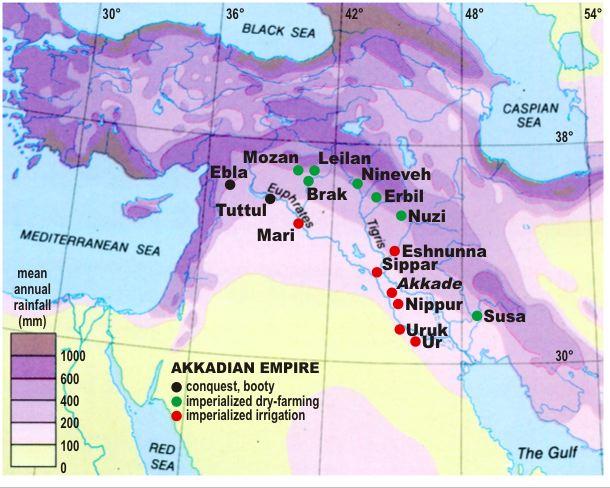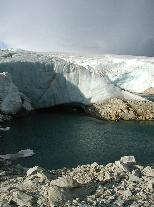 |
|
LAMONT-DOHERTY EARTH OBSERVATORY THE EARTH INSTITUTE AT COLUMBIA UNIVERSITY |
||
| Abrupt Climate Change | ||
| LDEO | ||
| Home | ||
| Divisions | ||
| LDEO Search | ||
| Abrupt CC | ||
| Home | ||
| Q&A | ||
| Contacts | ||
| Research | ||
| Links |
|
back to Q&A 2: What scientific evidence do we have that abrupt climate change has happened before?
Evidence of abrupt climate change comes from all manners
of sources (glacial deposits, tropical and polar ice caps, pollens, lake and
marine sediments, tree rings, corals, speleothems, etc). Confidence in identifying
such changes rises when more than one data source, and in more than one region,
records the event. Many abrupt changes can be readily identified since the
peak of the last ice age, but let us consider two examples with very different
causes and consequences.
1. The Younger Dryas
What is the Younger Dryas?
An event that occurred about 12,800 years before present (BP),
termed the Younger Dryas (YD), is the canonical example of abrupt climate change.
It is best seen in the Greenland ice cores, although it had very marked consequences
over Europe, North America, and as far as New Zealand. The YD is an invaluable
case study: it occurred recently enough so that records of it are
well-preserved, and seems to have left traces all over the world.
Let us look at the temperature over Greenland for the last 18,000 years:
Figure 1: The Younger Dryas event as an example of abrupt climate change. Source: Abrupt Climate Change; Inevitable Surprises Around 15,000 years ago, the Earth started warming abruptly after ~ 100,000 years of an "ice age"; this is known as a glacial termination. The large ice sheets, which covered significant parts of North America and Europe, began melting as a result. A climatic optimum known as the "Bölling-Allerød" was reached shortly thereafter, around 14,700 before present. However, starting at about 12,800 BP, the Earth returned very quickly into near glacial conditions (i.e. cold, dry and windy), and stayed there for about 1,200 years: this is known as the Younger Dryas (YD), since it is the most recent interval where a plant characteristic of cold climates, Dryas Octopetala, was found in Scandinavia. The most spectacular aspect of the YD is that it ended extremely abruptly (around 11,600 years ago), and although the date cannot be known exactly, it is estimated from the annually-banded Greenland ice-core that the annual-mean temperature increased by as much as 10°C in 10 years.
Why was there a Younger Dryas?
This is a touchy subject that is currently the focus of much research. One explanation is the one involving a thermohaline circulation (THC) shutdown, triggered by a catastrophic discharge of freshwater from Lake Agassiz (figure 2). The consequence is a rapid reduction in northward ocean heat transports, leading to an abrupt cooling over Northern Europe and North America. That is why so much attention is focused on the behavior of the North Atlantic ocean circulation: not only by scientists, but also Hollywood screenplay writers. Bear in mind, however, that the greenhouse world we are creating through fossil fuel burning might not behave at all like the Earth of 12,800 years ago, so that this scenario may be irrelevant for future climate change.
Figure 2: (Left) The outline of Lake Agassiz just before the catastrophic flood. At that time its outlet was to the south into the Mississippi drainage. (Right) The outline after the opening of the eastward outlet. A volume of 9500 cubic kilometers of water was suddenly released to the northern Atlantic through the St. Lawrence Valley (Leverington et al. 2000). (Source: Broecker, 2003) A problem with this hypothesis is the timing of meltwater pulses that are supposed to have triggered the THC shutdown: it was found that a second meltwater pulse, albeit slightly smaller than the first one, occurred at the end of the YD (Fairbanks, 1989): why didn't it also trigger a similar chain of consequences in the climate system? An alternate explanation (Clement et al., 2001) invokes the abrupt cessation in the El Nino -Southern Oscillation in response to changes in the orbital parameters of the Earth, although how such a change would impact regions away from the Tropics remains to be explained. The respective merits of both hypotheses have been laid out by Broecker (2003). The issue is far from being settled, and actively researched at Lamont and elsewhere.
Were there any other events like this one?
There are many other examples of abrupt climate change in the last 50,000 years, which bear the rather cryptic names of Heinrich, and Dansgaard/Oeschger events. The picture below (figure 2) shows where Dansgaard/Oeschger (DO) events have been recorded. More details on those are provided on this link.
Figure 3: Locations of the main records of abrupt climate change in the last 40,000 years. The inserted curve is a proxy for the temperature of precipitated snow over Greenland. (Source: Wallace Broecker) From this inserted panel, it is clear that the YD was a very strong event, yet it is also apparent that it was only the most recent of a series of large and abrupt climate swings that occurred repeatedly in the last ice age, and were recorded in many places around the globe, as attested by the number of red dots on the picture. Although they are of considerable theoretical interest, all these oscillations (including the YD) occurred at a time when parts of the Northern Hemisphere continents were covered by ice sheets, and the subpolar oceans where covered by sea-ice in winter. This makes such cases less relevant for understanding what might happen to our greenhouse world as a result of human activities. A better analog would be the Late Paleocene Thermal Maximum (about 55 million years ago, when the Earth was very warm), but the information about this period is frustratingly sparse because it is so remote in time. Let us then switch to another, more recent, and socially dramatic example: 2. The Akkadian collapse (Mesopotamia, 4200 calendar yr B.P.)Under the rule of Sargon of Akkad, the first empire was established between about 4300 and 4200 calendar years before present (B.P). on the broad, flat alluvial plain between the Tigris and Euphrates Rivers (Weiss et al., 1993). Akkadian imperialization of the region linked the productive but remote rain-fed agricultural lands of northern Mesopotamia with the irrigation agriculture tracts of southern Mesopotamian cities. After about a hundred years of prosperity, however, the Akkadian empire collapsed abruptly at 4170 ± 150 calendar yr B.P. (Weiss et al., 1993; Postgate, 1992). Archaeological evidence documents widespread abandonment of the agricultural plains of northern Mesopotamia (Weiss et al., 1993) and dramatic influxes of refugees into southern Mesopotamia, where populations swelled (Weiss et al., 1993, Weiss, 2000). A 180-km-long wall, the "Repeller of the Amorites," was built across central Mesopotamia to stem nomadic incursions to the south. Resettlement of the northern plains by smaller, sedentary populations occurred near 3900 calendar yr B.P. , about 300 years after the collapse. The stratigraphic level representing the collapse at Tell Leilan, northeast Syria, is overlain by a meter-thick accumulation of wind-blown fine sediments, suggesting a sudden shift to more arid conditions. Social collapse evidently occurred despite archaeological evidence that the Akkadians had implemented grain storage and water regulation technologies to buffer themselves against the large interannual variations in rainfall that characterize this region (Weiss et al., 1993). It has been recently proposed (Cullen et al. 2000) that the demise of this complex civilization is due to a prolonged period of drought starting at 4025 ±150 years). Paleoclimatic evidence is given in Figure 4.
Figure 4: Late Holocene record of Mesopotamian aridity as reconstructed from the quantity of wind-borne sediment components in a deep-sea core retrieved in the Gulf of Oman. The shaded grey area highlights a period spike in wind-blown sediments in the core, dating by radiocarbon methods . For such a high quantity of terrestrial dust to have been uplifted from Mesopotamia and transported to the sea, it is inferred that a drought persisted for about 300 years. (Source: deMenocal, 2001) Geochemical similarity of volcanic tephra shards found at Tell Leilan and in the deep-sea sediment core provided further evidence that the Akkadian collapse and climate change events were synchronous (Cullen et al, 2000). Enhanced regional aridity is also indicated by increased wind-blown quartz deposition in nearby Lake Van at the headwaters of the Tigris River (Lemcke and Sturm, 1997) and by paleoclimate records from the Levant (Bar-Matthews et al., 1997). The combined archaeological and paleoclimate evidence strongly implicates abrupt climate change as a key factor leading to the demise of this highly complex society. The onset of sudden aridification in Mesopotamia near 4100
calendar yr B.P. coincided with a widespread cooling in the North Atlantic (Bond
et al., 1997; deMenocal et al., 2000). During this event,
termed Holocene Event 3 (Fig. 5, below), Atlantic subpolar
Figure 5: The 4100 drought put it the context of the last 20,000 years. Panel A displays a proxy for the temperature of precipitation over Greenland. Panel B shows the fraction of lithic grains per gram in the northern North Atlantic, which is interpreted as a proxy for iceberg discharge there. Panel C shows a proxy for the sea-surface temperature (SST) off North West Africa. (Source: deMenocal, 2001) The headwaters of the Tigris and Euphrates Rivers are fed by elevation-induced capture of winter Mediterranean rainfall. Analysis of the modern instrumental record shows that large (50%) year-to-year reductions in Mesopotamian water supply result when subpolar northwest Atlantic sea surface temperatures are anomalously cool (Cullen and deMenocal, 2000). The aridification of Mesopotamia near 4200 calendar yr B.P. may thus have been related to the onset of cooler sea surface temperatures in the North Atlantic, the ultimate cause of which has not yet been elucidated. Equally obscure is why similar coolings (1 and 2 in the curve above) did not trigger similar droughts. The example of such a "mega-drought" and its dire consequences is particularly revealing of the vulnerability of complex societies to abrupt changes in our current climate, often believed to be much more stable than that of the "glacial world". From Panel A in figure 5, one would think that the last 11,000 years have been rather uneventful, and this is quite true in terms of temperature changes in Greenland. However, we see here that this did not preclude marked, regional changes in precipitation spanning entire decades, or even centuries in this case. To further confirm the modern relevance of such abrupt climate change, we present below a map of the estimated extent of the Akkadian empire:
Figure 6: Map of the Akkadian empire (source: http://research.yale.edu/leilan/akkadian/) A quick comparison to a map of the modern Middle East, reveals that were such a megadrought to occur today over former Mesopotamia, which is now a region of exquisite geopolitical sensitivity, it would still have profound human consequences on the region. Judging by the history of the last 3 years, it would also have global strategic consequences. References |
|
||

NGDC |
Modeling Observations Paleoclimate |

NAS Report on Abrupt Climate Change |

LDEO CORC/ARCHES Project |
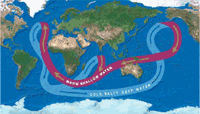
The trigger for the Younger Dryas |

Cultural responses to climate change |

Solar influence on climate change |
LDEO home | search | webmaster | site map | terms-of-use | support LDEO
Copyright © 2003 by The Trustees of Columbia University in the City of New York, Lamont-Doherty Earth Observatory.
All rights reserved.
